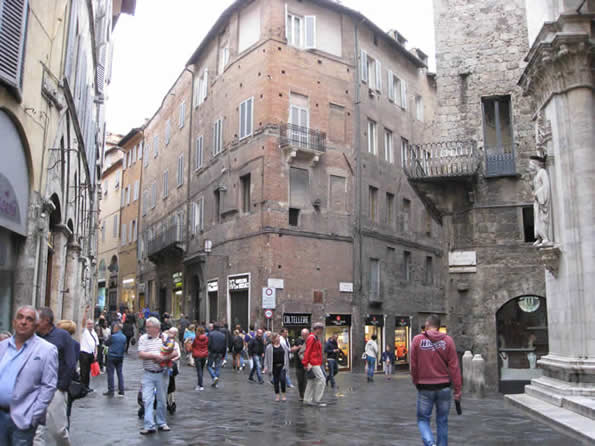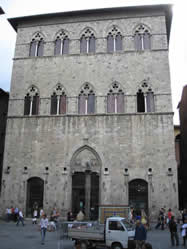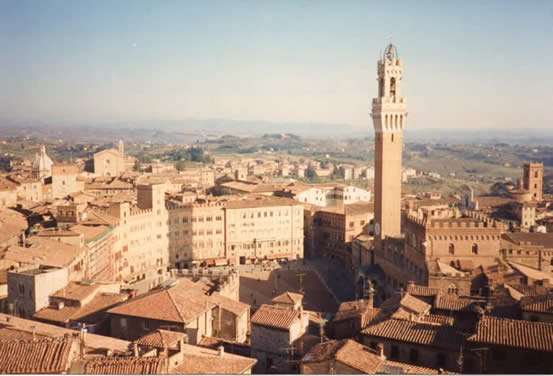STREETS AND PALAZZI
The backbone of Siena, anciently and today, is the main street that starts in the North at the Porta Camollia (the ancient gateway into Siena from Florence), where it is called via Camollia; after that it becomes first via Montanini and then Banchi di Sopra. It leads down to the Piazza del Campo (normally known simply as the "Campo"), the beautiful main square, where it splits into two. The left hand fork, Banchi di Sotto goes on down to the Porta Romana, the gateway to the ancient main road to Rome. This is the way that travellers from Florence to Rome and pilgrims on the Via Francigena took in ancient times. The right hand fork, via di Città, leads out to the Porta San Marco and the road towards the south-west.

Looking down via di Città towards the three-way junction or “Travaglio” – Rome to the right, Florence to the left. The marble arcaded building just visible on the right is the 15th century Loggia della Mercanza, which in olden times housed an internationally respected commercial court.
These streets are lined with medieval Palazzi (which originally would almost all have had towers) built by Siena's leading familes. The main ones include:
- Palazzo Salimbeni, on the Piazza Salimbeni off the Banchi di Sopra. Its white marble Gothic façade is one of the most reproduced images of Siena, but in fact much of it is the result of some heavy remodelling in the 19th century. It was the ancient home of the Salimbeni family and is now the headquarters of Siena’s ancient bank, the Monte dei Paschi di Siena. It was established in the 15th century, is the oldest continuously operating bank in the world and is still a dominant force in Sienese affairs, contributing major subsidies to charitable and artistic activities (although it has had to make major cuts in its activities following the fimancial crisis, when it had to be rescued by the Italian government). It was originally established as a state-run “Monte di Pietà” – a medieval credit institution for lending to the poor. The word “Paschi” was added in the 16th century and comes from an old word for “pasture lands”, as part of the finance for the bank was provided by bonds based on the revenues of pasture lands in the Maremma, south of Siena. The Bank (which has quite a good art collection) does organised tours of the building, but they are not easy to arrange.

Palazzo Salimbeni
- Palazzo Tolomei, further down the Banchi di Sopra on the other side facing Piazza Tolomei. It was built in the mid-1200s and is a good example of a gothic private residence. The Tolomei were rivals of the Salimbeni, and it is perhaps fitting the Palazzo Tolomei now houses the Sienese headquarters of the Florentine bank that is the Monte dei Paschi’s main rival.
|
 |
- Palazzo delle Papesse at 126 via di Città. This massive palazzo was built in 1485 for the sister of the Piccolomini pope Pius II, and designed by the Florentine Bernardo Rossellini, the architect of Pienza. It is very much in the Florentine renaissance style, reminiscent of the Palazzo Pitti with its great rusticated blocks of stone. The palazzo was opened in the late 1990s as a gallery of contemporary art, but has now closed again. The collections formerly in it have been moved to the museum complex at Santa Maria della Scala opposite the Duomo.
- Palazzo Chigi-Saracini at 82 via di Città, a beautiful gothic structure with a lovely courtyard, dating from the 1300s (although the tower dates back to the 1100s). Before the Palazzo Pubblico was built, it briefly housed the Sienese government. It now houses a musical academy and if there are any concerts on at it, they are well worth attending both for the music and the chance of visiting the interior (which includes some good works of art). There are some guided tours at other times.

Courtyard of the Palazzo Chigi-Saracini
The Campo
The sloping scallop-shell-shaped Campo, where the Palio is run twice a year, is one of the most famous squares in Italy if not the world. The Town Hall or Palazzo Pubblico straddles the lower side, and ten lines of travertine marble radiate out from in front of it, dividing the Campo into nine segments, said the represent "The Nine" (I Noveschi), the medieval government of nine magnates who laid out the Campo in its present form in 1349. The great medieval families of Siena built their palazzi round the hemi-circle of the scallop shell. Most have been much changed over the centuries, and now all have cafés, restaurants or shops at their base. The cafés and restaurants are expensive (and the restaurants not partticularly good), but well worth it for the view over this fabulous square.

The Campo seen from above (photo via wikimedia)

Painting of the procession of the Contrade around the Campo in 1546. Note that several of
the palazzi still have their towers. (Photo by Vincenzo Rustici via wikimedia)
- Palazzo Sansedoni is the most impressive of the palazzi on the Campo. It was built in the 1300s, but reconstructed in 1767, so its medieval look is probably too good to be true. But it is still a fantastic building.

Palazzo Sansedoni in the centre; Palazzo Chigi-Zondadari on the right.
- Palazzo Chigi-Zondadari, to the right of the Palazzo Sansedoni, is probably the most recently built, being a graceful 18th century building, nevertheless fitting well with its medieval or pseudo-medieval neighbours. It was built by a Roman architect for a Sienese cardinal called Zondadari, demonstrating the being a cardinal was still a good guarantee of riches in those days.
- Palazzo Pannochieschi d'Elci or degli Alessi, the tall crenellated building on the other side of the Campo, was first erected in the 1200s by the Alessi family; but was then taken over by the Pannochiesci d'Elci family and remodeled in the 1500s. It was remodelled twice more over the centuries, so it is hard to tell how much of its medieval appearance is genuine. But again it is a fine building and the café at its foot is a good place in which to sit and admire the Campo..

Palazzo degli Alessi in the centre with the crenellations
2012 and 2014.
Minor changes 2014.
|

